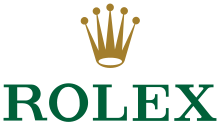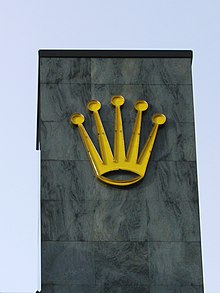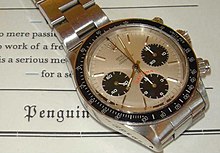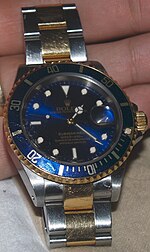Rolex
| ROLEX SA
|
|
|---|---|
| legal form | Corporation |
| founding | 1905 in London |
| Seat |
Geneva , Switzerland |
| management |
|
| Number of employees | unknown |
| sales | unknown |
| Branch | Watch manufacture |
| Website | www.rolex.com |
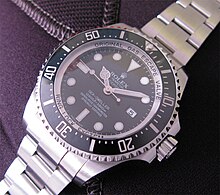





Rolex SA ( spelling ROLEX ) is an independent watch manufacturer with headquarters in Geneva ( Switzerland ). The Swiss manufacturer produces mechanical wristwatches in the luxury segment and is 100% controlled by the Hans Wilsdorf Foundation. Rolex is probably the most famous watch brand in the world.
Company history
Company founded in London (1905)
Founder of Rolex was the German immigrant Hans Wilsdorf , 1893 with only 12 years orphan was. At a boarding school in Coburg , he met a young Swiss man, through whom he came to La Chaux-de-Fonds at the age of 19 to work as a foreign language correspondent in the watch export business of Cuno Kourten . After he successfully ordered pocket watches from master watchmakers there, received a certificate of accuracy for them from the Neuchâtel Observatory and then exported them to Great Britain , he decided in 1905 to emigrate to the UK himself and set up his own business in London . With his brother-in-law Alfred Davis, he founded the company Wilsdorf & Davis in London in 1905 . Wilsdorf & Davis imported Swiss clockworks from Jean Aegler to Great Britain in order to offer them there as Schweitzer clocks from Wilsdorf & Davis after completion.
Finding a name (1908)
In the early 1900s , it was common for watches to bear the name of the seller and not the manufacturer. This practice presented Wilsdorf with an enormous challenge when choosing a name for the watch models from Wilsdorf & Davis. Wilsdorf himself explained, quote:
“The obstacles seemed insurmountable at first; but I knew that there would be no future for us if we didn't succeed in making our watch known under its own name. The first step was to choose the name itself. It was so short and so memorable that the name of the English watch shop would have enough space next to it on the dial. But what is particularly valuable: ROLEX sounds good, is easy to remember and is also pronounced the same in all European languages. "
Rolex was the first watch manufacturer to write the brand name on the dial, but this transition was carried out very gently, so that in the 1930s , wristwatches without Rolex imprint were still sold. The etymological origin of the word for Rolex has not yet been scientifically clarified. Historians and watch collectors disagree on the origin and meaning of the name Rolex. The widely spread assumption that the name Rolex is an acronym from the English words Rol ling Ex port (dt. "Rolling export") has never been proven historically. There are no official sources for the origin of the brand name, the Rolex company itself writes on its homepage , quote:
“I (Hans Wilsdorf) tried to combine the letters of the alphabet in all directions - with the result that after a while I had hundreds of names available, but wasn't really satisfied with any of them. One morning, while I was sitting on the upper deck of the horse-drawn bus that was traveling along Cheapside in the City of London, a good spirit whispered to me: ROLEX "
It is historically documented that Hans Wilsdorf registered ROLEX as an official trademark on July 2, 1908 in the London Patent and Trademark Office under number 24.001 .
Move to Biel (1915)
In order to avoid the high import duties during the First World War , Wilsdorf moved the entire company headquarters from London to Biel (Switzerland) in 1915 . Because important sales markets abroad collapsed due to the war, Wilsdorf concentrated at this time on establishing Rolex as a new young brand in Switzerland. In addition, the rebuilding, during the war, was more demanding and time-consuming than planned. It was not until January 17, 1920 that Wilsdorf in Geneva was able to officially register the Montres Rolex SA company in the Swiss commercial register. At that time Wilsdorf was the sole owner and responsible for the management of Rolex.
Long before his competitors, Wilsdorf recognized a huge market for wristwatches , which were not very widespread until the early 1920s and were mainly worn by women as pure jewelry accessories . Men mostly wore pocket watches during this period. It was also believed that the case size of wristwatches was too small for the movements of the time. Herrmann Aegler, however, encouraged his long-time friend and business partner Hans Wilsdorf to fulfill his dream of wristwatches for everyone . Aegler supplied the appropriate small movements and was able to prove their functionality with accuracy certificates. Even before the First World War, the partners promised each other with a handshake that they would work together exclusively. However, a written contract for the following decades of collaboration never existed.
Marketing success (1927)
In 1926, Rolex introduced the world's first patented waterproof watch under the name Oyster . On October 7, 1927, the London secretary Mercedes Gleitze was the first English woman to attempt to swim the English Channel . Wilsdorf recognized the opportunity to make his new watch known to the general public. He gave Gleitze an Oyster watch on the condition that it be worn when crossing the canal and thus to prove to the whole world the outstanding technical quality of his invention. Gleitze agreed. Their attempt failed due to the adverse weather conditions just before reaching the French coast. The Rolex Oyster wore the slide around its neck while swimming, withstood the effects of salt water without any problems and still ran accurately after eight hours in cold water. For Hans Wilsdorf, Mercedes Gleitze's failed canal crossing was a sensational PR triumph. A month later, for £ 4,000, he launched a full-page advertisement for the Daily Mail . The slogan: The wonder watch that defies the elements made the Rolex brand world famous in November 1927. The barrel-shaped design used from the 1930s onwards has remained largely unchanged since then. In 1931, Rolex first installed an automatic movement (self-winding) in the waterproof Oyster Perpetual wristwatch and patented it worldwide.
Customer service in the Second World War (1939–1945)
When it became known that many German officers in the Second World War took British prisoners of war off their Rolex watches in order to wear them themselves, Hans Wilsdorf ordered
"[...] that every British soldier who wants to buy a Rolex watch before going to war does not have to pay for his Rolex until it comes back with him from the war."
The Rolex company has never forgotten this gesture, especially among British customers. One year before the end of the war, Hans Wilsdorf's first wife (Florence Frances May Wilsdorf-Crotty) died on April 26, 1944. In 1945 Wilsdorf established a non-profit foundation under the name Fondation Hans Wilsdorf (Hans Wilsdorf Foundation).
Model innovations (1950s)
In 1953 the Submariner was presented for the first time , which is now considered a prototype for diving watches. Thanks to the triple sealing system Triplock , the Submariner at that time had achieved a water resistance of 100 m (Ref. 6204). Today the Submariner is tested up to 30 bar, which corresponds to the pressure of an assumed water column of 300 meters. Watches in this group are suitable , for example, for device-independent apnea diving . Another important diving watch , which was further developed from the Submariner in 1971, is the Sea-Dweller model , which had a helium valve for deep-sea divers . At that time it was waterproof to 610 m. For the first ascent of Mount Everest in 1953, Rolex developed the Explorer watch model , which can withstand temperature differences of up to 70 ° C. 1954 mandated US - airline Pan Am , the company Rolex to design a timepiece that displays a second time zone. The background: on transatlantic flights, the planes pass through several time zones. At that time, both Greenwich Mean Time (GMT) and the local time at the destination had to be available. The innovative solution from Rolex: a fourth hand for the GMT-Master . This fourth hand rotates the dial within 24 hours and shows the second zone time on a rotating bezel, which appears blue in the upper part and red in the lower part. On September 30, 1953, Rolex carried out a watch test in the deep sea for the first time . Rolex attached a specially designed diving watch to the outer wall of the Trieste submarine . Back then, the diving watch survived a record depth of 3,150 meters. The deep sea explorer Auguste Piccard was on board the Trieste with his son Jacques Piccard . The same watch model passed a second deep-sea test on January 23, 1960, this time in the Mariana Trench ( Pacific ). This Rolex managed 10,916 meters of water , which corresponds to the pressure of about a ton.
The five-point crown above the Rolex logo has not been changed in terms of design since the late 1950s . Today it is the main component of the Rolex brand.
Death of Hans Wilsdorf (1960)
On September 19, 1959, Wilsdorf gave his first and only television interview . Hans Wilsdorf died on July 6, 1960 at the age of 79 in his summer residence Escale-Fleurie in Geneva. Wilsdorf was married twice. The marriages remained childless, and Wilsdorf's second wife, Bertha Betty Wilsdorf-Mettler, died in 1989.
Wilsdorf bequeathed his million dollar fortune and 100% ownership rights to ROLEX SA to the Hans Wilsdorf Foundation. Since then, this foundation has been subordinate to Swiss foundation law in accordance with Articles 80 to 89 of the Civil Code (ZGB) . Today the Wilsdorf Foundation is the sole owner of ROLEX SA. Only the Wilsdorf Foundation determines and is responsible for the corporate development of Rolex.
Race with Seiko (1960s)
In the 1960s, Rolex competed with the Japanese watch company Seiko for the very first quartz wristwatch . The Japanese won the race and in December 1969 presented the world public with the Seiko Quartz-Astron, the world's first series-production quartz wristwatch. The Swiss company (only) presented the Rolex Quartz Date (Ref. 5100), the first quartz wristwatch from Rolex, in April 1970 . Due to the given factory shape, Rolex could no longer use an Oyster case at that time , as it would have been too large. The resulting watch was only available in yellow or white gold; 900 copies were made in yellow gold and 99 in white gold, none of which had normal serial numbers but only their limited edition numbers. The series was sold out before production started.
The myth of the steel Daytona (since 1969)
Motor sport competitions were held regularly on the sandy beach in Daytona ( USA ) between 1903 and 1935 . 80 official records were set at Daytona, including 14 US speed records. Daytona became known as the world capital of speed . Rolex founder Hans Wilsdorf recognized the marketing potential in motorsport early on and promoted the English racing driver Malcolm Campbell , who set several world records. Since then, the promotion of motorsport has been normal marketing practice at Rolex. In 1963, Rolex presented the first chronograph under the name Rolex Daytona . The presentation of the chronograph at the time, which Rolex calls the Cosmograph, was not a special event in the watch industry. The Geneva manufacturer had already produced a robust chronograph in 1947, even with additional functions such as a full calendar. In the mid-1960s, a Rolex Dayton cost around 1400 francs in Switzerland. At that time, the Daytonas were in little demand and were spurned by many Rolex concessionaires as unpopular slow-moving goods .
It was not until the Hollywood blockbuster Indianapolis from 1969, where Hollywood star Paul Newman played the racing driver Frank Capua and wore a steel Daytona, that the Rolex chronograph became world-famous and a cult object . In particular, the models with steel cases from the late 1960s (1967 to 1971) are now reaching record sums and are in great demand all over the world. The famous Paul Newman Daytonas are extremely popular with watch collectors and auction houses . Distinguishing features are:
- three black totalizers
- white dial behind plexiglass
- Second hand with white arrowhead
- red lettering for Daytona and minute track
- two unscrewable chronograph pushers without side protection
- Stainless steel bezel with engraved tachymeter display, the scale of the tachymeter display is black
These models are offered today at watch auctions starting at € 100,000. A Daytona, with reference 6239, from the private collection of Paul Newman was auctioned for the equivalent of € 15.3 million in 2017 and was the most expensive wristwatch in the world at the time.
Tudor as a second brand
In 1936, Hans Wilsdorf acquired the rights to the Tudor brand from Swiss watchmaker Philippe Hüther. The new (cheaper) Tudor brand should specialize in women's and men's collections alike. Rolex SA guaranteed the technical, aesthetic and functional properties, as well as sales and customer service. Today, the Tudor brand uses, among other things, works purchased from ETA SA .
Standard movement
The Rolex caliber 3135, on which all three-hand watches from Rolex are based in various designs, is structurally designed for robustness, accuracy and long maintenance intervals. It has some design features, such as red anodized components, a Breguet hairspring and a winding mechanism in which the axis of the flywheel is mounted in a seat made of synthetic ruby (normally the rotor mechanism is made of steel in steel as ball bearings). The regulation does not take place, as with most mechanical movements, via a counter pointer, which changes the effective length of the hairspring, but via the Microstella system. The star-shaped nuts mounted on the inside of the balance wheel change the balance's moment of inertia by adjusting them.
Current caliber
All calibers installed by Rolex are certified as chronometers by the COSC .
- Rolex 2231, undated (used in Oyster Perpetual)
- Rolex 3130, without date, with Parachrom blue hairspring (used in Submariner No Date)
- Rolex 3132, undated, with Parachrom blue hairspring (used in Explorer I and Oyster 39mm)
- Rolex 3135, with date and Parachrom blue hairspring (used in Submariner Date and Sea-Dweller Deepsea)
- Rolex 3235, with date and Parachrom blue hairspring and Chronergy escapement and 70 hours power reserve (used in Sea-Dweller - Ref. 126600 and Deepsea 126610)
- Rolex 3136, with date and Parachrom blue hairspring (used e.g. in Datejust II)
- Rolex 3156, weekday, with Parachrom blue hairspring (used in Day-Date)
- Rolex 3186, GMT function, Parachrom blue hairspring (used in GMT-Master II 116710LN and BLNR and old Explorer II - Ref. 16570)
- Rolex 3285, GMT function, Parachrom blue hairspring and Chronergy escapement and 70 hours power reserve (used in GMT-Master II 126710BLRO)
- Rolex 3187, GMT function, separately adjustable Parachrom blue hairspring and Paraflex anti-shock system (caliber previously used exclusively in the new Explorer II - Ref. 216570)
- Rolex 4130, chronograph function, without date (used in Cosmograph Daytona)
- Rolex 9001, with date, annual calendar, GMT function (used in Sky-Dweller)
Brand image
In addition to some historically based peculiarities, the following unique selling points have contributed to the current image of the watch brand Rolex:
- Almost all of the currently (2020) available watch models have existed in their current form since the 1950s. Although there have been technical adjustments to most models, these adjustments have been made very slowly and in cautious steps over the past 70 years. This continuity is one of the main reasons why the Rolex brand is so popular with watch collectors.
- The strict quality standards that Rolex has in the manufacture of its watches are exemplary in the industry.
- All watches are checked for accuracy by the independent Swiss inspection body COSC .
- Material processing, precision, functional reliability and the longevity of Rolex watches are internationally recognized.
- In the used watch trade, the watches from Geneva have only a marginal loss in value (depending on their condition). In private sales, even less popular Rolex models achieve a relatively high used market price.
Rolex watches from the gray market
The demand for certain professional models, such as a steel Daytona , a Batman with a Jubilee band or a Submariner Hulk , has increased massively since the 2010s . Years of waiting at official Rolex dealers are normal for certain models. In order to avoid this waiting time, some private customers are ready to acquire their dream model faster on the gray market . Gray dealers take advantage of this demand and then charge significantly more for a Rolex than the actual list price .
Dealers who are active in the gray market purchase Rolex models, often abroad, in order to benefit from differences in VAT and / or currency fluctuations. Some even work unofficially with concessionaires. These gray dealers then, for example, officially buy a Rolex at the list price from the concessionaire and then immediately sell it again (unworn and in its original packaging) to private customers at a much higher gray market price. The profit is then, of course unofficially, shared between the gray dealer and the official concessionaire. For the official concessionaire, this has the advantage that he always fulfills his sales targets for the watch manufacturer and also makes a private profit (untaxed and outside the official balance sheet). Private customers do not have to wait years for their dream watch and watch manufacturers benefit indirectly from the brand's hype without investing large sums of money in marketing.
Sponsorship
Rolex is very active in marketing with celebrities from sports, science, music and the arts around the world. Rolex sponsors more than 100 major events - from the tennis championships at Wimbledon to the awarding of the Oscars to the Venice Architecture Biennale. Rolex also sponsors more than 140 brand ambassadors, including tennis player Roger Federer , marine biologist Sylvia Earle, and director Martin Scorsese. The Nobel Prize for Literature Ernest Hemingway was the recipient of a Rolex Perpetual , which he even immortalized in his work Across the River and Into the Forests . Chancellor Konrad Adenauer also owned a Rolex, possibly a gift from the Geneva company. Rolex supports the following events :
- ISAF Rolex World Sailor of the Year Awards
- America's Cup Hall of Fame
- Rolex Fastnet Race
- Rolex Awards for Enterprise
- Rolex Sports Car Series
- Le Mans 24 hour race
- formula 1
- Grand Slam of show jumping
Corporate culture
Rolex SA is an extremely conservative and extremely secretive company. In principle, Rolex does not publish any business figures. The watch manufacturer allegedly produces between 700,000 and 900,000 watches a year and employs between 6,000 and 8,000 people. Official figures and dates are not known. According to its own information, the company has 28 branches worldwide and a network of over 4,000 watchmakers licensed by Rolex . Since the company was founded in 1905, Rolex has registered and protected over 400 patents. In 2004, the two legally independent companies, were Rolex SA and Montres Rolex SA to the new Rolex SA merged . On the Forbes world rankings for 2016 and 2017, Rolex was ranked first for the most respected brand in the world.
Rolex Germany is based in Cologne .
literature
- Rolex anniversary 1905–1920–1945. Montres Rolex SA, Geneva 1945.
- Rolex Jubilee Vade Mecum. 4 volumes. Montres Rolex SA, Geneva 1946.
- Hans Wilsdorf. Montres Rolex SA, Geneva 1960.
- Franz-Christoph Heel (Ed.): Rolex - wrist watches . Heel, Königswinter 2009, ISBN 978-3-86852-189-4 .
- Martin Skeet, Nick Urul: Classic Rolex Sports Watches. All model series since 1952. Heel Verlag Königswinter 2011, ISBN 978-3-86852-468-0 .
- Kesaharu Imai: Rolex. 2421 watches. Callwey, Munich.
- Centenary of the factory 1878–1978. Manufacture des Montres Rolex, Biel 1978.
- George Gordon: Rolex. Hans Wilsdorf and the Evolution of Time. Hong Kong 1989.
- Anton Kreuzer , Gisbert A. Joseph: Rolex. Klagenfurt 1991.
- Osvaldo Patrizzi: Rolex wristwatches. Geneva 1991.
- Helmut Kahlert , Richard Mühe , Gisbert L. Brunner : Wristwatches: 100 years of development history. Callwey, Munich 1983; 5th edition ibid. 1996, ISBN 3-7667-1241-1 , pp. 40 f. (Caliber 100 to 1530) and more often.
Web links
Individual evidence
- ↑ https://iwc.com.pk/the-hans-wilsdorf-story-founder-of-rolex/
- ↑ https://www.gq-magazin.de/mode/artikel/rolex-alles-fachwissen-und-die-statement-pieces-der-luxus-uhrenmarke
- ↑ https://www.bachmann-scher.de/magazin/luxusuhren-markenstories/rolex/rolex-markenstory-und-geschichte.html?tx_bswatches_watches%5Bcategory%5D=20&cHash=5a6b7823ebe9227dc1ce9657708acea9
- ↑ https://www.kulmbach.de/xist4c/web/Hans-Wilsdorf---Kulmbach_id_802_.htm
- ^ Helmut Kahlert, Richard Mühe, Gisbert L. Brunner, Christian-Pfeiffer-Belli: wrist watches: 100 years of development history. Callwey, Munich 1983; 5th edition, ibid. 1996, ISBN 3-7667-1241-1 , p. 501.
- ↑ Hans Wilsdorf: Rolex Jubilee Vademecum: Volume 1 From level to level. Montres Rolex SA 1945. p. 14.
- ↑ https://www.rolex.com/de/about-rolex-watches/1905-1919.html
- ↑ The Rolex Principle. In: Weltwoche 12/17
- ↑ https://www.gf-luxury.com/3-geheimnisse-ueber-rolex-uhren/
- ↑ Roger Ruegger: The Rolex Deep-Sea Special diveintowatches.com, 2003
- ↑ https://www.watchtime.net/uhren-wissen/5-ffekten-ueber-rolex/
- ↑ https://www.zeitjuwel.de/uhren/blaken---rolex---nuernberg---zeitjuwel/blaken-pan-am-gmt-m.html?language=de
- ↑ https://www.youtube.com/watch?v=HnZSZxyC0ZQ
- ↑ https://www.youtube.com/watch?v=b2qVPLbZrko
- ↑ https://www.uhrenkosmos.com/rolex-daytona-chronograph-technik-geschichte-2/
- ↑ https://www.spiegel.de/stil/rolex-daytona-von-paul-newman-ist-die-teuerste-uhr-der-welt-a-1174986.html
- ↑ https://www.handelsblatt.com/archiv/manche-modelle-sind-immer-rar-glanz-vom-graumarkt/2287860-all.html
- ↑ https://www.wiwo.de/lifestyle/luxusuhren-das-gute-graue-geschaeft-mit-rolex-und-omega/20078526.html
- ↑ https://www.gq-magazin.de/mode/artikel/rolex-alles-fachwissen-und-die-statement-pieces-der-luxus-uhrenmarke
- ↑ Carlo Janka is promoting the luxury watch brand Rolex, Schweizer Illustrierte , March 6, 2010
- ↑ Wolfgang Stock: Hemingways Uhr , in Hemingwayswelt.de, from July 3, 2013
- ^ Rose-Maria Gropp: Konrad Adenauer's bling-bling. faz.net November 5, 2011 ; Retrieved November 9, 2011
- ↑ Company study by the Branding Institute (PDF)
- ↑ rolexmagazine.com
